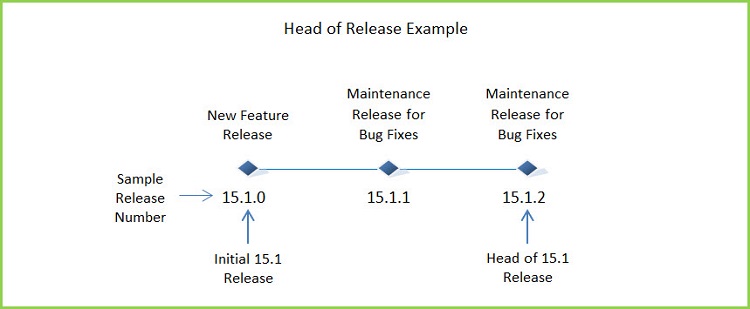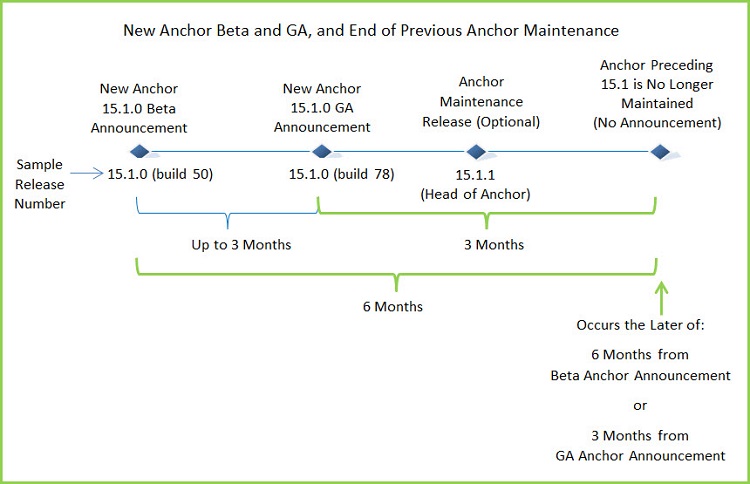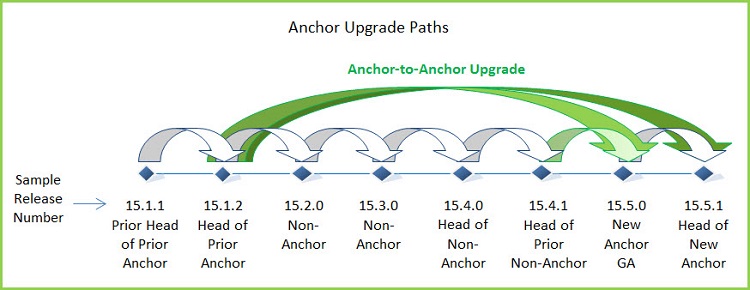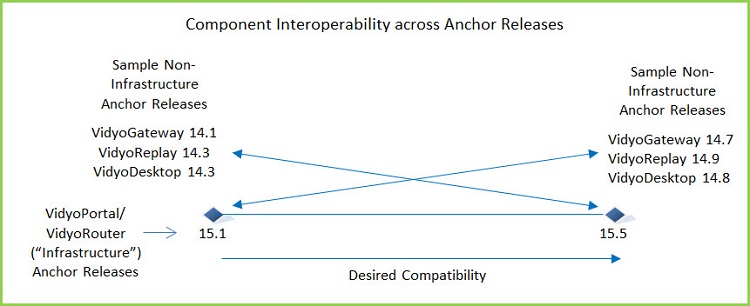Vidyo Standard Software Maintenance Policy
Executive Summary
Vidyo provides two types of standard software releases:
- Anchor releases — Optimal for customers who place the highest value on stability and long-term support with minimal changes.
- Maintenance releases for the Anchor deliver critical bug fixes only, minimizing stability risk.
- Vidyo targets two Anchor Releases per year, and provides six months to transition from one Anchor to the next, minimizing churn of the production environment.
- Non-Anchor Releases – Optimal for customers who place the highest value on agility in adopting important new functionality.
- Priority bug fixes for Non-Anchor Releases will usually be delivered in the following release, which may also include new functionality.
- Non-Anchor Releases are made more frequently than Anchor Releases and may require upgrade to both Vidyo server and client software concurrently.
Introduction
This document describes the Vidyo Software Maintenance Policy and defines Anchor and Non-Anchor software releases.
Vidyo reserves the right to make changes and/or exceptions to this policy and process without notice. This document does not indicate a commitment on the part of Vidyo to include any specific features or release any specific hardware or software. All hardware and software will be released on an if-and-when available basis.
Furthermore, this policy applies only to software that has been made generally available by Vidyo. Vidyo does not commit to maintaining demo software, beta software, and other software that has not been released for general availability.
Release Numbering
In this document, the terms “version” and "release” are used interchangeably.
Vidyo generally numbers software releases using the x.y.z.R format where:
- x denotes a major feature release.
- y denotes a minor or major feature release.
- z denotes a maintenance release (hot fix) release. These releases are referred to as “maintenance releases” or “z releases” interchangeably.
- R denotes the revision or build number.
Major releases (x.y) may have multiple z releases. Vidyo will increment the z designation every time it issues a maintenance release.
"Head of" Releases
The latest z release (that is, the release with the highest z digit for a given x.y) is called the Head of such a release.
Anchor Releases
An Anchor Release is a release that has been designated an Anchor by a Vidyo Product Bulletin. Vidyo typically offers a new Anchor Release to customers twice a year. Any release that has not been designated as an Anchor Release by Vidyo is a Non-Anchor Release.
The initial Anchor Release can introduce new features, changes to the user interface, and changes to the APIs. In order to minimize risk and reduce customer overhead associated with accepting new functionality, any following maintenance releases to the Anchor Release will only deliver critical bug fixes; features, user interface, or APIs will not be changed except to fix bugs or critical usability issues. Vidyo sometimes refers to the Head of the Anchor Release as the “Head of the Anchor”.
The Vidyo Anchor release compatibility matrix lists the current Anchor releases for each Vidyo infrastructure and endpoint component. In addition, if you are an on-premises customer, refer to the Vidyo compatibility matrix for on-premises to see a list of all the current releases (including Non-Anchor releases) and their interoperability across Vidyo components. If you are a cloud-only customer, the Compatibility Matrix for On-Premises does not pertain to you because Vidyo will upgrade software as needed and ensure that cross-product compatibility is maintained.
New Anchor Beta Announcement
Vidyo announces new Anchor Beta Releases via Product Bulletins. The purpose of the Anchor Beta Announcement is to enable customers to plan and prepare for the upcoming Anchor release.
Hence, Vidyo typically provides, together with the announcement, a Beta of the new x.y Anchor Release software and its associated APIs for customers’ lab testing and integration.
New Anchor General Availability (GA) Announcement
Typically, within 90 days after announcement of the Beta Anchor, Vidyo provides the GA Anchor Release for that Vidyo Product.
End of Software Maintenance for Anchor Releases
For a given product, an Anchor Release will be maintained until whichever comes last:
- 6 months after the new Anchor Beta Announcement of the following Anchor Release.
- 3 months after Vidyo announces, via a Product Bulletin, the General Availability of the following Anchor Release.
End of Maintenance for Anchor Releases is automatic, based on the above guidelines. Vidyo will make no public announcements about software release End of Maintenance.
Designating and Announcing a Previously Released GA Version as an Anchor Release
Vidyo may designate a previously released GA version as an Anchor Release. This designation and announcement will be made through a Product Bulletin and without a preceding New Anchor Beta Announcement. Consideration for said release will include the customer’s feedback, feature set, and other compatibility requirements or needs. In the event of such an announcement, Vidyo will try to maintain the time frame described in “New Anchor Release General Availability (GA) Announcement” section for previously announced Anchor Releases, allowing customers a timely transition.
Moving to a New Anchor
Customers can upgrade to the Head of a new Anchor Release from either:
- The Head of the immediately preceding Anchor Release.
- The Head of the immediately preceding Non-Anchor Release.

Component Interoperability across Anchor Releases
Typically, a new Anchor Release for the “Infrastructure” components (VidyoPortal and VidyoRouter) is compatible with the preceding Anchor Release of the “Endpoints” (VidyoGateway, VidyoDesktop, Vidyo-Room, etc.). This enables customers to upgrade their Infrastructure before upgrading their Endpoints.
Similarly, new Anchor Releases for Endpoints are typically compatible with the preceding Anchor Release of the Infrastructure. This enables customers to upgrade their Endpoints before upgrading the Infrastructure.
Deviations, if any, to the previous two paragraphs will be documented in the Release Notes or as part of the Anchor announcement Product Bulletin.
Additionally, a new Anchor Release for the Infrastructure components (VidyoPortal and VidyoRouter) is typically compatible with the latest Non-Anchor Release for the Endpoints preceding the initial release of the Infrastructure Anchor Release. This simplifies customers’ transitions from a Non-Anchor Infrastructure to an Anchor Infrastructure: customers can start by upgrading their Infrastructure to the Anchor Release, and later upgrade their endpoints.
Production
Vidyo ships products with a pre-installed Anchor Release, though not necessarily the latest Anchor or the Head of an Anchor.
Vidyo recommends that customers run their systems on the Head of a release. Therefore, if customers want to upgrade to the Head, they must manually do so. Likewise, if customers want to deploy a different version (such as an older Anchor or a new Non-Anchor Release), then they must install the software manually.
Non-Anchor Releases
Non-Anchor Releases may have both bug fixes and new feature content (the latter denoted by an increment to the x or y digit).
Vidyo announces new Non-Anchor (x.y) Releases via Product Bulletins. Occasionally, Vidyo offers early Non-Anchor Releases for Beta.
Moving to a New Non-Anchor Release
Customers can upgrade to a new Non-Anchor Release from the immediately preceding release. Vidyo may additionally provide a direct upgrade path in case upgrading to the Head of this Non-Anchor from the Head of the immediately preceding x.y release requires more than three manual release upgrades.
Component Interoperability for Non-Anchor Releases
Non-Anchor Releases have strict compatibility requirements, and may mandate the simultaneous upgrade of all Infrastructure and Endpoints.
End of Software Maintenance for Non-Anchor Releases
Non-Anchor Releases are maintained up to 45 days after the next major or minor release becomes generally available.
End of Maintenance for Non-Anchor Releases is automatic, based on the above guidelines. There will be no public announcements about software release End of Maintenance.
App Store Applications
Mobile store-based applications (e.g., mobile/tablet clients) will be compatible only with currently maintained releases. Customers can use MDM solutions to tightly control which version is delivered and installed for their devices.
Vidyo Third-Party Software Support Policy
Vidyo licenses and integrates third-party software into our products and platform. As part of the Vidyo Product Development Life Cycle (PDLC), all third-party software integrated for each new product version is reviewed for the following:
- The third-party software package is under support (per the software vendor original support model) for the expected release time of the current planned version and any subsequent planned version.
- The software is patched to include the latest security updates available at the time of the review.
Vidyo will execute this policy to the best of its ability, but reserves the right to make exceptions.
Vidyo Endpoints Software Support Policy – Operating Systems, Drivers, and Browsers
Vidyo endpoint applications, such as VidyoConnect for Desktop, VidyoConnect for Mobile (iOS and Android), VidyoConnect for WebRTC, VidyoConnect Room software, and VidyoPlatform API and SDK run on and rely on the host operating systems, drivers, and browser capabilities, as well as on their vendor standard support policy (as opposed to their extended policy). The Vidyo Standard Software Support Policy supports the last two major releases of the following operating systems:
- Windows
- macOS
- iOS
- iPadOS
- Android